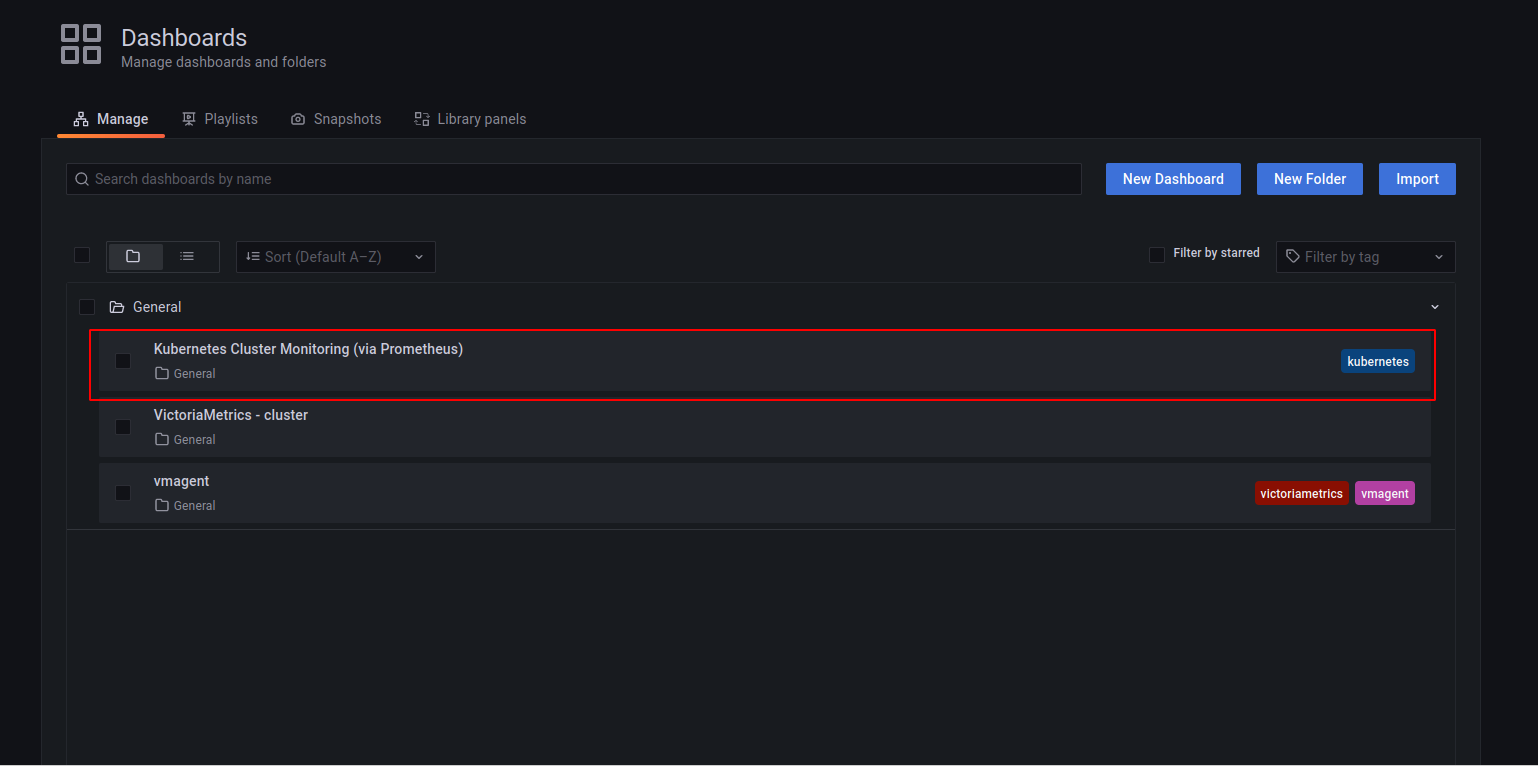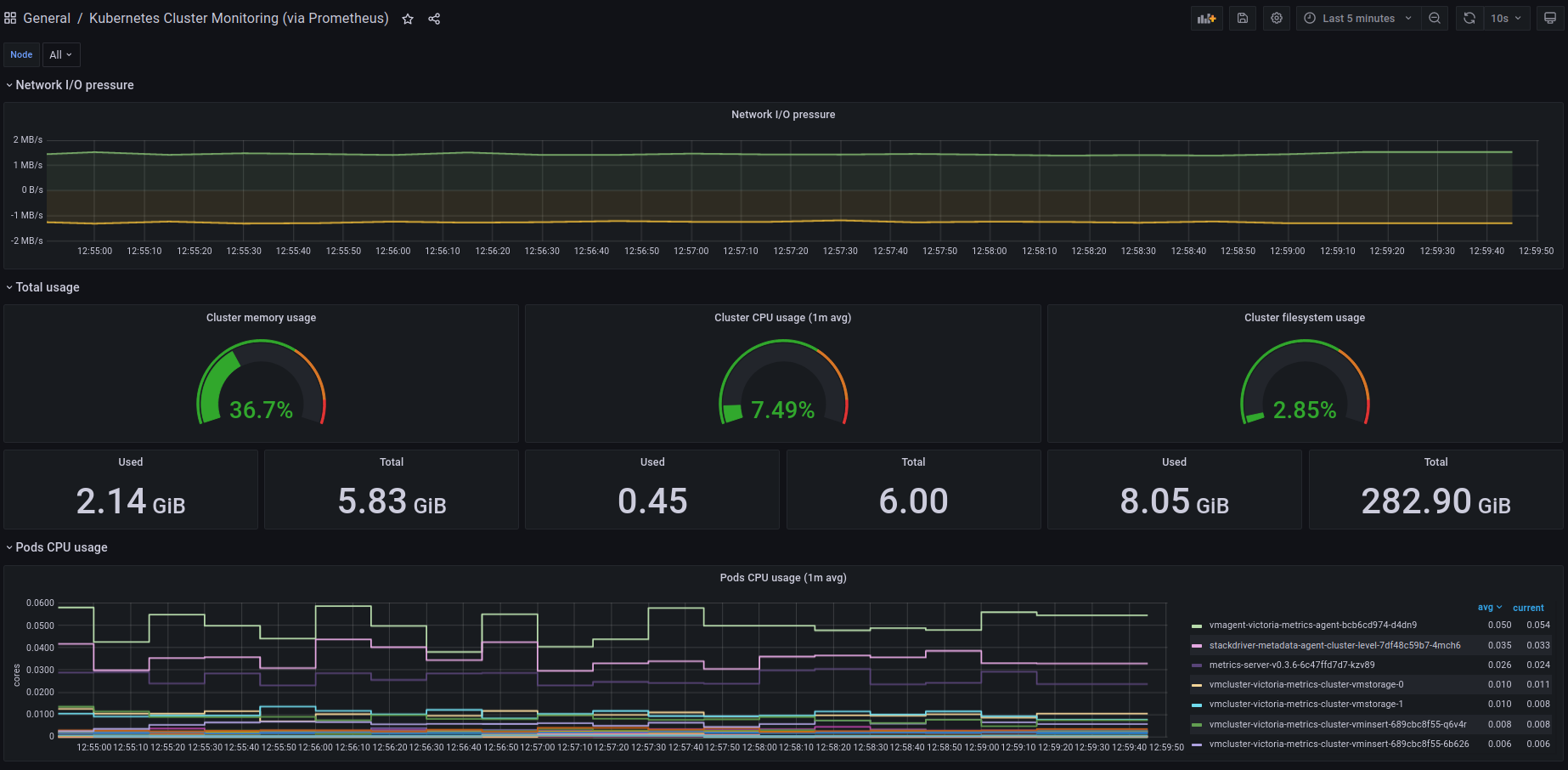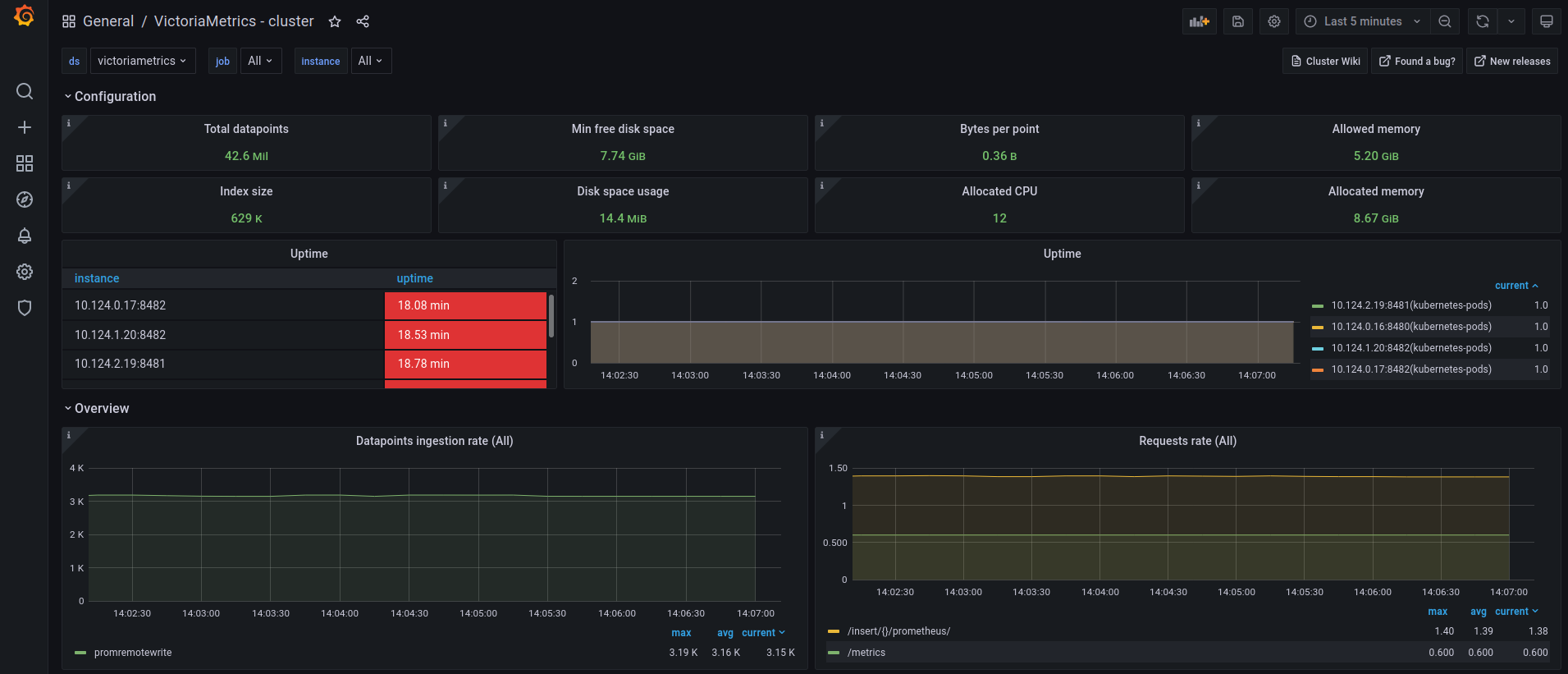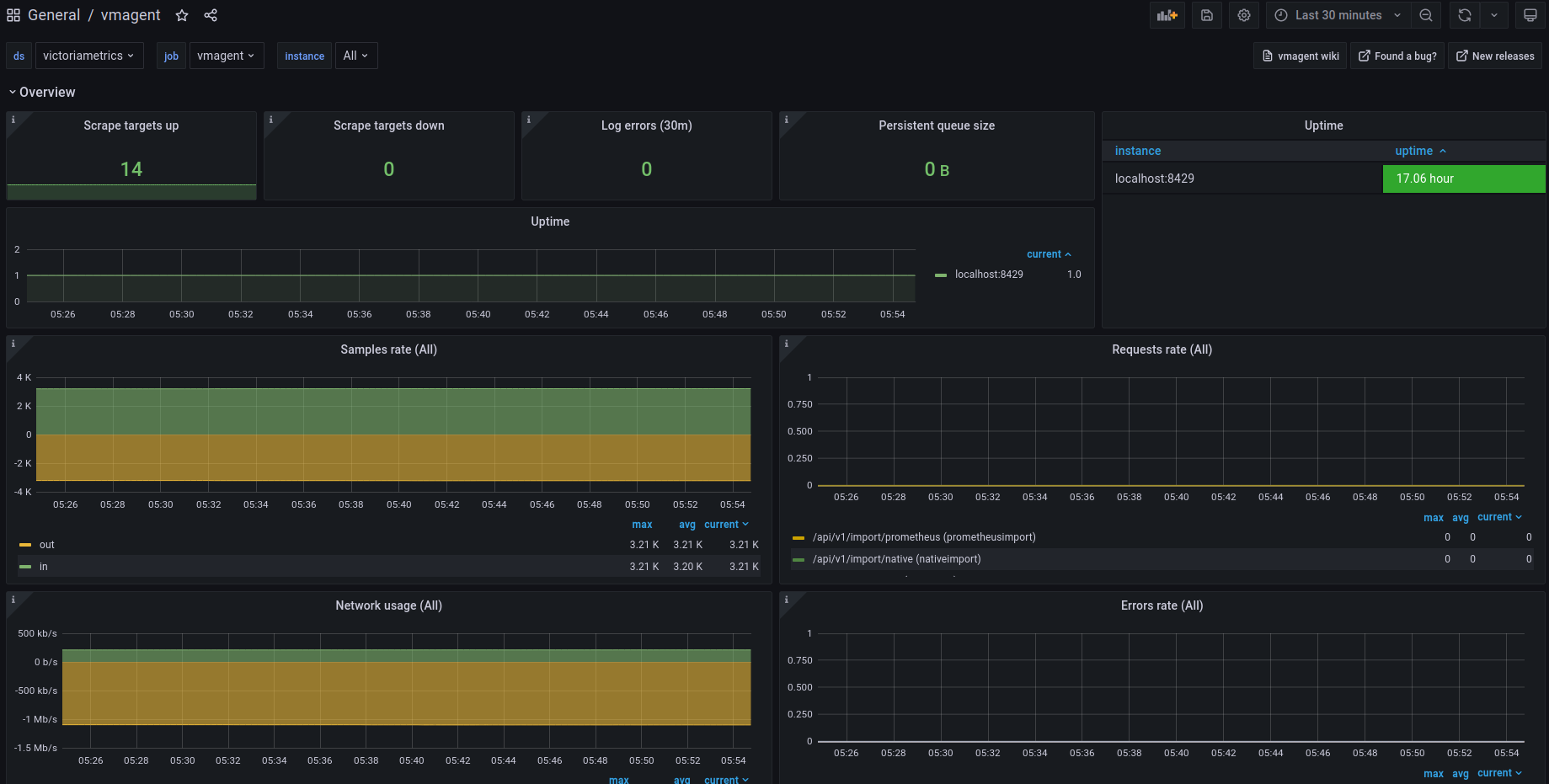# Kubernetes monitoring with VictoriaMetrics Cluster
**This guide covers:**
* The setup of a [VictoriaMetrics cluster](https://docs.victoriametrics.com/Cluster-VictoriaMetrics.html) in [Kubernetes](https://kubernetes.io/) via Helm charts
* How to scrape metrics from k8s components using service discovery
* How to visualize stored data
* How to store metrics in [VictoriaMetrics](https://victoriametrics.com) tsdb
**Precondition**
We will use:
* [Kubernetes cluster 1.19.9-gke.1900](https://cloud.google.com/kubernetes-engine)
> We use GKE cluster from [GCP](https://cloud.google.com/) but this guide also applies on any Kubernetes cluster. For example [Amazon EKS](https://aws.amazon.com/ru/eks/).
* [Helm 3 ](https://helm.sh/docs/intro/install)
* [kubectl 1.21](https://kubernetes.io/docs/tasks/tools/install-kubectl)

## 1. VictoriaMetrics Helm repository
> For this guide we will use Helm 3 but if you already use Helm 2 please see this [https://github.com/VictoriaMetrics/helm-charts#for-helm-v2](https://github.com/VictoriaMetrics/helm-charts#for-helm-v2)
You need to add the VictoriaMetrics Helm repository to install VictoriaMetrics components. We’re going to use [VictoriaMetrics Cluster](https://docs.victoriametrics.com/Cluster-VictoriaMetrics.html). You can do this by running the following command:
```bash
helm repo add vm https://victoriametrics.github.io/helm-charts/
```
Update Helm repositories:
```bash
helm repo update
```
To verify that everything is set up correctly you may run this command:
```bash
helm search repo vm/
```
The expected output is:
```bash
NAME CHART VERSION APP VERSION DESCRIPTION
vm/victoria-metrics-agent 0.7.20 v1.62.0 Victoria Metrics Agent - collects metrics from ...
vm/victoria-metrics-alert 0.3.34 v1.62.0 Victoria Metrics Alert - executes a list of giv...
vm/victoria-metrics-auth 0.2.23 1.62.0 Victoria Metrics Auth - is a simple auth proxy ...
vm/victoria-metrics-cluster 0.8.32 1.62.0 Victoria Metrics Cluster version - high-perform...
vm/victoria-metrics-k8s-stack 0.2.9 1.16.0 Kubernetes monitoring on VictoriaMetrics stack....
vm/victoria-metrics-operator 0.1.17 0.16.0 Victoria Metrics Operator
vm/victoria-metrics-single 0.7.5 1.62.0 Victoria Metrics Single version - high-performa...
```
## 2. Install VictoriaMetrics Cluster from the Helm chart
Run this command in your terminal:
```yaml
cat <
* By running `Helm install vmcluster vm/victoria-metrics-cluster` we install [VictoriaMetrics cluster](https://docs.victoriametrics.com/Cluster-VictoriaMetrics.html) to default [namespace](https://kubernetes.io/docs/concepts/overview/working-with-objects/namespaces/) inside your cluster.
* By adding `podAnnotations: prometheus.io/scrape: "true"` we enable the scraping of metrics from the vmselect, vminsert and vmstorage pods.
* By adding `podAnnotations:prometheus.io/port: "some_port" ` we enable the scraping of metrics from the vmselect, vminsert and vmstorage pods from their ports as well.
As a result of this command you will see the following output:
```bash
NAME: vmcluster
LAST DEPLOYED: Thu Jul 1 09:41:57 2021
NAMESPACE: default
STATUS: deployed
REVISION: 1
TEST SUITE: None
NOTES:
Write API:
The Victoria Metrics write api can be accessed via port 8480 with the following DNS name from within your cluster:
vmcluster-victoria-metrics-cluster-vminsert.default.svc.cluster.local
Get the Victoria Metrics insert service URL by running these commands in the same shell:
export POD_NAME=$(kubectl get pods --namespace default -l "app=vminsert" -o jsonpath="{.items[0].metadata.name}")
kubectl --namespace default port-forward $POD_NAME 8480
You need to update your Prometheus configuration file and add the following lines to it:
prometheus.yml
remote_write:
- url: "http:///insert/0/prometheus/"
for example - inside the Kubernetes cluster:
remote_write:
- url: "http://vmcluster-victoria-metrics-cluster-vminsert.default.svc.cluster.local:8480/insert/0/prometheus/"
Read API:
The VictoriaMetrics read api can be accessed via port 8481 with the following DNS name from within your cluster:
vmcluster-victoria-metrics-cluster-vmselect.default.svc.cluster.local
Get the VictoriaMetrics select service URL by running these commands in the same shell:
export POD_NAME=$(kubectl get pods --namespace default -l "app=vmselect" -o jsonpath="{.items[0].metadata.name}")
kubectl --namespace default port-forward $POD_NAME 8481
You will need to specify select service URL in your Grafana:
NOTE: you need to use Prometheus Data Source
Input this URL field in Grafana
http:///select/0/prometheus/
for example - inside the Kubernetes cluster:
http://vmcluster-victoria-metrics-cluster-vmselect.default.svc.cluster.local:8481/select/0/prometheus/"
```
For us it’s important to remember the url for the datasource (copy lines from the output).
Verify that [VictoriaMetrics cluster](https://docs.victoriametrics.com/Cluster-VictoriaMetrics.html) pods are up and running by executing the following command:
```bash
kubectl get pods
```
The expected output is:
```bash
NAME READY STATUS RESTARTS AGE
vmcluster-victoria-metrics-cluster-vminsert-689cbc8f55-95szg 1/1 Running 0 16m
vmcluster-victoria-metrics-cluster-vminsert-689cbc8f55-f852l 1/1 Running 0 16m
vmcluster-victoria-metrics-cluster-vmselect-977d74cdf-bbgp5 1/1 Running 0 16m
vmcluster-victoria-metrics-cluster-vmselect-977d74cdf-vzp6z 1/1 Running 0 16m
vmcluster-victoria-metrics-cluster-vmstorage-0 1/1 Running 0 16m
vmcluster-victoria-metrics-cluster-vmstorage-1 1/1 Running 0 16m
```
## 3. Install vmagent from the Helm chart
To scrape metrics from Kubernetes with a [VictoriaMetrics cluster](https://docs.victoriametrics.com/Cluster-VictoriaMetrics.html) we need to install [vmagent](https://docs.victoriametrics.com/vmagent.html) with additional configuration. To do so, please run these commands in your terminal:
```yaml
helm install vmagent vm/victoria-metrics-agent -f https://docs.victoriametrics.com/guides/guide-vmcluster-vmagent-values.yaml
```
Here is full file content `guide-vmcluster-vmagent-values.yaml`
```yaml
remoteWriteUrls:
- http://vmcluster-victoria-metrics-cluster-vminsert.default.svc.cluster.local:8480/insert/0/prometheus/
config:
global:
scrape_interval: 10s
scrape_configs:
- job_name: vmagent
static_configs:
- targets: ["localhost:8429"]
- job_name: "kubernetes-apiservers"
kubernetes_sd_configs:
- role: endpoints
scheme: https
tls_config:
ca_file: /var/run/secrets/kubernetes.io/serviceaccount/ca.crt
insecure_skip_verify: true
bearer_token_file: /var/run/secrets/kubernetes.io/serviceaccount/token
relabel_configs:
- source_labels:
[
__meta_kubernetes_namespace,
__meta_kubernetes_service_name,
__meta_kubernetes_endpoint_port_name,
]
action: keep
regex: default;kubernetes;https
- job_name: "kubernetes-nodes"
scheme: https
tls_config:
ca_file: /var/run/secrets/kubernetes.io/serviceaccount/ca.crt
insecure_skip_verify: true
bearer_token_file: /var/run/secrets/kubernetes.io/serviceaccount/token
kubernetes_sd_configs:
- role: node
relabel_configs:
- action: labelmap
regex: __meta_kubernetes_node_label_(.+)
- target_label: __address__
replacement: kubernetes.default.svc:443
- source_labels: [__meta_kubernetes_node_name]
regex: (.+)
target_label: __metrics_path__
replacement: /api/v1/nodes/$1/proxy/metrics
- job_name: "kubernetes-nodes-cadvisor"
scheme: https
tls_config:
ca_file: /var/run/secrets/kubernetes.io/serviceaccount/ca.crt
insecure_skip_verify: true
bearer_token_file: /var/run/secrets/kubernetes.io/serviceaccount/token
kubernetes_sd_configs:
- role: node
relabel_configs:
- action: labelmap
regex: __meta_kubernetes_node_label_(.+)
- target_label: __address__
replacement: kubernetes.default.svc:443
- source_labels: [__meta_kubernetes_node_name]
regex: (.+)
target_label: __metrics_path__
replacement: /api/v1/nodes/$1/proxy/metrics/cadvisor
metric_relabel_configs:
- action: replace
source_labels: [pod]
regex: '(.+)'
target_label: pod_name
replacement: '${1}'
- action: replace
source_labels: [container]
regex: '(.+)'
target_label: container_name
replacement: '${1}'
- action: replace
target_label: name
replacement: k8s_stub
- action: replace
source_labels: [id]
regex: '^/system\.slice/(.+)\.service$'
target_label: systemd_service_name
replacement: '${1}'
- job_name: "kubernetes-service-endpoints"
kubernetes_sd_configs:
- role: endpoints
relabel_configs:
- action: drop
source_labels: [__meta_kubernetes_pod_container_init]
regex: true
- action: keep_if_equal
source_labels: [__meta_kubernetes_pod_annotation_prometheus_io_port, __meta_kubernetes_pod_container_port_number]
- source_labels:
[__meta_kubernetes_service_annotation_prometheus_io_scrape]
action: keep
regex: true
- source_labels:
[__meta_kubernetes_service_annotation_prometheus_io_scheme]
action: replace
target_label: __scheme__
regex: (https?)
- source_labels:
[__meta_kubernetes_service_annotation_prometheus_io_path]
action: replace
target_label: __metrics_path__
regex: (.+)
- source_labels:
[
__address__,
__meta_kubernetes_service_annotation_prometheus_io_port,
]
action: replace
target_label: __address__
regex: ([^:]+)(?::\d+)?;(\d+)
replacement: $1:$2
- action: labelmap
regex: __meta_kubernetes_service_label_(.+)
- source_labels: [__meta_kubernetes_namespace]
action: replace
target_label: kubernetes_namespace
- source_labels: [__meta_kubernetes_service_name]
action: replace
target_label: kubernetes_name
- source_labels: [__meta_kubernetes_pod_node_name]
action: replace
target_label: kubernetes_node
- job_name: "kubernetes-service-endpoints-slow"
scrape_interval: 5m
scrape_timeout: 30s
kubernetes_sd_configs:
- role: endpoints
relabel_configs:
- action: drop
source_labels: [__meta_kubernetes_pod_container_init]
regex: true
- action: keep_if_equal
source_labels: [__meta_kubernetes_pod_annotation_prometheus_io_port, __meta_kubernetes_pod_container_port_number]
- source_labels:
[__meta_kubernetes_service_annotation_prometheus_io_scrape_slow]
action: keep
regex: true
- source_labels:
[__meta_kubernetes_service_annotation_prometheus_io_scheme]
action: replace
target_label: __scheme__
regex: (https?)
- source_labels:
[__meta_kubernetes_service_annotation_prometheus_io_path]
action: replace
target_label: __metrics_path__
regex: (.+)
- source_labels:
[
__address__,
__meta_kubernetes_service_annotation_prometheus_io_port,
]
action: replace
target_label: __address__
regex: ([^:]+)(?::\d+)?;(\d+)
replacement: $1:$2
- action: labelmap
regex: __meta_kubernetes_service_label_(.+)
- source_labels: [__meta_kubernetes_namespace]
action: replace
target_label: kubernetes_namespace
- source_labels: [__meta_kubernetes_service_name]
action: replace
target_label: kubernetes_name
- source_labels: [__meta_kubernetes_pod_node_name]
action: replace
target_label: kubernetes_node
- job_name: "kubernetes-services"
metrics_path: /probe
params:
module: [http_2xx]
kubernetes_sd_configs:
- role: service
relabel_configs:
- source_labels:
[__meta_kubernetes_service_annotation_prometheus_io_probe]
action: keep
regex: true
- source_labels: [__address__]
target_label: __param_target
- target_label: __address__
replacement: blackbox
- source_labels: [__param_target]
target_label: instance
- action: labelmap
regex: __meta_kubernetes_service_label_(.+)
- source_labels: [__meta_kubernetes_namespace]
target_label: kubernetes_namespace
- source_labels: [__meta_kubernetes_service_name]
target_label: kubernetes_name
- job_name: "kubernetes-pods"
kubernetes_sd_configs:
- role: pod
relabel_configs:
- action: drop
source_labels: [__meta_kubernetes_pod_container_init]
regex: true
- action: keep_if_equal
source_labels: [__meta_kubernetes_pod_annotation_prometheus_io_port, __meta_kubernetes_pod_container_port_number]
- source_labels: [__meta_kubernetes_pod_annotation_prometheus_io_scrape]
action: keep
regex: true
- source_labels: [__meta_kubernetes_pod_annotation_prometheus_io_path]
action: replace
target_label: __metrics_path__
regex: (.+)
- source_labels:
[__address__, __meta_kubernetes_pod_annotation_prometheus_io_port]
action: replace
regex: ([^:]+)(?::\d+)?;(\d+)
replacement: $1:$2
target_label: __address__
- action: labelmap
regex: __meta_kubernetes_pod_label_(.+)
- source_labels: [__meta_kubernetes_namespace]
action: replace
target_label: kubernetes_namespace
- source_labels: [__meta_kubernetes_pod_name]
action: replace
target_label: kubernetes_pod_name
```
* By adding `remoteWriteUrls: - http://vmcluster-victoria-metrics-cluster-vminsert.default.svc.cluster.local:8480/insert/0/prometheus/` we configuring [vmagent](https://docs.victoriametrics.com/vmagent.html) to write scraped metrics into the `vmselect service`.
* The second part of this yaml file is needed to add the `metric_relabel_configs` section that helps us to show Kubernetes metrics on the Grafana dashboard.
Verify that `vmagent`'s pod is up and running by executing the following command:
```bash
kubectl get pods | grep vmagent
```
The expected output is:
```bash
vmagent-victoria-metrics-agent-69974b95b4-mhjph 1/1 Running 0 11m
```
## 4. Install and connect Grafana to VictoriaMetrics with Helm
Add the Grafana Helm repository.
```bash
helm repo add grafana https://grafana.github.io/helm-charts
helm repo update
```
See more information on Grafana ArtifactHUB [https://artifacthub.io/packages/helm/grafana/grafana](https://artifacthub.io/packages/helm/grafana/grafana)
To install the chart with the release name `my-grafana`, add the VictoriaMetrics datasource with official dashboard and the Kubernetes dashboard:
```yaml
cat <
By running this command we:
* Install Grafana from the Helm repository.
* Provision a VictoriaMetrics data source with the url from the output above which we remembered.
* Add this [https://grafana.com/grafana/dashboards/11176](https://grafana.com/grafana/dashboards/11176) dashboard for [VictoriaMetrics Cluster](https://docs.victoriametrics.com/Cluster-VictoriaMetrics.html).
* Add this [https://grafana.com/grafana/dashboards/12683](https://grafana.com/grafana/dashboards/12683) dashboard for [VictoriaMetrics Agent](https://docs.victoriametrics.com/vmagent.html).
* Add this [https://grafana.com/grafana/dashboards/14205](https://grafana.com/grafana/dashboards/14205) dashboard to see Kubernetes cluster metrics.
Please see the output log in your terminal. Copy, paste and run these commands.
The first one will show `admin` password for the Grafana admin.
The second and the third will forward Grafana to `127.0.0.1:3000`:
```bash
kubectl get secret --namespace default my-grafana -o jsonpath="{.data.admin-password}" | base64 --decode ; echo
export POD_NAME=$(kubectl get pods --namespace default -l "app.kubernetes.io/name=grafana,app.kubernetes.io/instance=my-grafana" -o jsonpath="{.items[0].metadata.name}")
kubectl --namespace default port-forward $POD_NAME 3000
```
## 5. Check the result you obtained in your browser
To check that [VictoriaMetrics](https://victoriametrics.com) collects metrics from k8s cluster open in browser [http://127.0.0.1:3000/dashboards](http://127.0.0.1:3000/dashboards) and choose the `Kubernetes Cluster Monitoring (via Prometheus)` dashboard. Use `admin` for login and `password` that you previously got from kubectl.

You will see something like this:

The VictoriaMetrics dashboard is also available to use:

vmagent has it’s own dashboard:

## 6. Final thoughts
* We set up TimeSeries Database for your Kubernetes cluster.
* We collected metrics from all running pods,nodes, … and stored them in a VictoriaMetrics database.
* We visualized resources used in the Kubernetes cluster by using Grafana dashboards.





